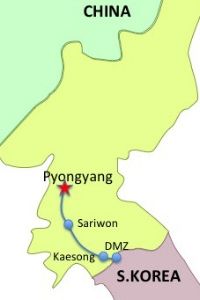Kaesong - ancient capital of Korea
HOW TO GET THERE | KAESONG | MAP | KORYO MUSEUM | TOMB OF KING KONGMIN | TOMB OF KING WANGGON | OTHER ATTRACTIONS | SOUVENIRS | CUISINE | HOTELS | AROUND KAESONG
Kaesong is a small city at the border with South Korea (only 8 km from the DMZ with South Korea), it was a former capital of the Koryo Dynasty (918–1392 CE) for several hundred years and was the only major city that changed hands between North and South Korea as a result of the Korean War. Because of this Kaesong is the only city in Korea which has preserved its original historical make up as it wasn't destroyed during the Korean war. Twelve historic monuments and sites in Kaesong were inscribed to the UNESCO World Heritage List in 2013
How to get to Kaesong
Kaesong is about 160 km south from Pyongyang towards South Korea. From Pyongyang it takes about 3 hours drive by bus or 2 hours by a private car to get to this peaceful city. Most of our group tours make a stop in Kaesong on the way back to Pyongyang from DMZ (8 km from Kaesong)
Kaesong
Kaesong was the capital of Koryo (918-1392), first unified state on the Korean peninsula. It is divided in an old and a new cities areas. From old times Kaesong has been called as "Songak" or "Songdo" for many evergreen pine trees and fabulous landscape scienaries.
Nam Gate (South Gate). Built between 1391 and 1393, at the same time as the inner citadel of the walled city. The citadel used to have seven gates, but only Nam Gate is left. During the Korea War it was severely damaged and rebuilt in 1954. It still contains the 14 tonne Yŏnbok bell cast in 1346
Kaesong Old Town. The old town is one of the best preserved in all of Korea, and traditional Korean-style buildings dating back from the Joseon period can still be seen. However, it is typically not included on most tours, though tour guides who trust their groups enough are known to take tourists for a short walk through the old town
Students and Childrens’ Palace. A smaller version of the Children's Palace in Pyongyang
Kaesong Industrial Zone. increasingly well-known for the Kaesong Industrial Complex, a "special economic zone", developed by Hyundai Asan with North Korea. In 2012 this special administrative industrial region had over 50,000 North Korean workers typically working for about 20% of the South Korean minimum wage in dozens of brand-new factories operated by more than 100 different South Korean companies. In April 2013, North Korea recalled all 53,000 North Korean workers from the Kaesong Industrial complex, effectively suspending all of its operations. In response, South Korea withdrew all of its citizens working in Kaesong and threatened to give up on the venture. In October 2013 there have been small yet positive steps by both sides to resolve the issues and eventually resume operations
Koryo Museum. This museum was once the Songgyungwan Confucian Academy
Sonjuk Bridge in Koryo Museum. A small stone bridge dating back to 1216. It is only 7 meters long and 2.5 meters wide. Lee Bang Won, the third king of the Chosun Dynasty and son of first king of that dynasty, had his opponent Jong Mong Ju executed on this bridge in 1392. It is named after a bamboo that grew up beside the bridge.
Map and Main Attractions
1. Nam Gate |
4. Tomb of King Kongmin |
7. Kaesong Industrial Zone |

|
Koryo Songgyungwan University (고려성균관) and Koryo Museum
Songgyungwan is located two kilometers to the northeast of the center of the city of Kaesong. The university was founded in 992 with the name Kukchagam. It was renamed Songgyungam in 1298 and Songgyungwan in 1308. The Songgyungwan was the highest educational institution established during the Koryo and Choson Dynasties. The institution consists of the Taesong Temple, Myongnyun Hall and 20 other buildings, including one of the largest wooden buildings to still exist in the DPRK
Since 1987, it houses the Koryo Museum, where is stashed pottery, ironwork, prints and relics from the Koryo dynasty. This is all overlooked by 500-year old gingko trees and a 900-year-old zelkova. It takes 4 people to link arms around the large tree just within the museum entrance
Sonjuk Bridge. A small stone bridge dating back to 1216. It is only 7 meters long and 2.5 meters wide. Lee Bang Won, the third king of the Chosun Dynasty and son of first king of that dynasty, had his opponent Jong Mong Ju executed on this bridge in 1392. It is named after a bamboo that grew up beside the bridge.
Tomb of King Kongmin (Hyonjongrung Royal Tomb)
On a hill 13 km outside Kaesong are the tombs of King Kongmin and his queen; from the tombs there is a nice view of the surrounding scenery. This is a particularly good tomb to visit owing to it being in close to its original state with little reconstruction. The coffin of Kongmin can be seen nearby in the Koryo Museum in Kaesong.
Tomb of King Wanggon (Hyŏllŭng Royal Tomb)
King Wanggon was the founder of the Koryo Dynasty and died in 943. The original tomb was badly damaged by the end of the Japanese occupation, and most of the site today is apparently recently reconstructed
Other attractions
Pakyon Falls - one of the three famous falls in Korea, it is located about 25km north of the city center. At the top of the falls 37m high is 8m round pond named Pakyon. Below the falls is Komo Pool associated with a lot of legends.
Ryongthong Temple is the famous as the hole place of Korean Chonthae Sect of Buddhism, nestled at the Ryongthong Valley of Mt.Ogwan 12 km from the city centre. The temple was bult early in the Koryo dynasty and existed till the 16th century. In October 94 (2005) the temple was reconstructed.
Ch'ŏnju-sa Temple is located on the southern slope of Yaksan mountain, in Yŏngbyŏn, North Pyŏngan province. Founded 1684 during the mid-Joseon dynasty the temple today retains its main prayer hall, known as Pogwang Hall; the Ch'ŏnju Pavilion, once known as one of the six most scenic spots in Yongbyon.
Anhwa Temple it is one of the Kpryo-dynasty temples. It ws built in 930 on the mid slope of Mt.Songak. The temple consists of Taegung Hall, Myongbu Hall, Obaek Hall, 7-story pagoda and a dormitory.
Kwanmun Temple built in Koryo dynasty, it consists of Kwanmun Grotto, Taeung Hall, a dormitory, auxilary buildings, 7-story pagoda and some other minor buildings. First built in 970, it was enlarged in 1393, the present temple was rebuilt in 1464.
Chomsongdae it is an astronomical and meteorological observatory used during Koryo dynasty to carry out sunspot observations from 1024 till 1383. Dating from the early 10th century, it is regarded as the oldest structure for astronomical surveys in the world (together with its counterpart in Kyongju).
Taehungsan Fort is one of the fortresses to defend the Kaesong Fortress and its north gate. Originally encompassing both Mts. Chŏnma and Songgo, the castle was first founded as a fortress for the defense of the capital, encircled by over 10 kilometers of stone walls. Today, many of the walls have become overgrown ruins.
Souvenirs
Souvenirs such as DPRK stamps, books written by Kim Il Sung and Kim Jung Il, and Korean handicrafts are available, and not expensive. Stores selling souvenirs accept US dollars, euros and Chinese yuan. Ginseng is grown locally and is a particularly good buy both because of its quality and low price
Cuisine
As Kaesong was the capital of Koryo with almost 500 years of rule, its culinary culture was highly developed. The luxurious style of Kaesong cuisine is frequently compared with those of Seoul cuisine and Jeolla cuisine. Representative Kaesong dishes are:
- Pansanggi - is a set of dishes for a table. All dishes are put in same bowls capped with lids. A set of dishes ranges from 5 to 11 not counting boiled rice and soup
- Insam Takgom (boiled chicken with insam)
- Kaesong yakbap (boiled rice with vegetables)
- Bossam kimchi (wrapped kimchi)
- Pyeonsu (summer mandu in square shape)
- Sinseollo (royal casserole)
- Seolleongtang (beef tripe soup)
- Chueotang (mudfish soup)
- Joraengi teokguk(rice cake soup)
- Umegi (teok covered with syrup)
- Gyeongdan (ball-shaped teok)
- Umegi, also called Kaesong juak, is a holiday food of Kaesong, and known for the delicate style with the sweet taste
Kaesong is famous with a number of side-dishes which are surved during the meal: tourist can experience royal meal with up to 10 side-dishes. In Kaesong you also can try traditional Korean dog-meat soup and famous insam chicken soup
Insam / Ginseng
Kaesong is considered to be home of Koryo insam - the best insam (ginseng) in the Far East. Insam was used from old times in Korea. Wild insam cultivated in Koryo dynasty was called insam, distinctive from sansam (wild insam). It was cultivated in several areas but the soil, water and weather conditions of Kaesong were most favourable, thus it had biggest and most efficacious insam. From then on Kaesong Koryo Insam has been wide known. It does wonders for exciting the central nervous system, energy and fatigue. It functions anti-radioactivity and anti-cancer, so its medical sphere has been wider than before
Restaurants:
- Thongil Restaurant: nestled at the foot of Mt.Janam south of the city center
- Sohung Tea House: 30km from Sariwon towards Kaesong there is the Sohung Tea House that bridges the road, where according to korean guides "you can recover from fatigue and enjoy the nature" and have some tea, ginseng and beer, and taste some local snacks
Hotels
- Kaesong Minsok Folk Hotel: one-story traditional style houses built in the Ri dynasty (1392-1910), 50 rooms. Traditional Korean rest on the floor (it is called Ondol, in winter time the floor is heated)
- Janamsan Hotel: situated at the foot of Mt.Janam east of the city center, 43 rooms
Around Kaesong
- Panmunjom - a small village located on the Military Demarcation Line between South and North Korea where the Armistice Talks were held. It is located 8 km southeast of the Kaesong city center
- Concrete Wall - the wall, symbol of national division appears 27 km east of the city center. The wall was constructed by South Korea in 1979 and is designed to look like a natural hill from South Korean side and as a wall from the side of North Korea. It measures 240 km long,5-8 m high, 10-19m thick at the base with pillboxes and iron gates in different sites.
- DMZ - is a strip of land running across the Korean Peninsula that serves as a buffer zone between North and South Korea. The DMZ is a de-facto border barrier, which runs along the 38th parallel north. The DMZ cuts the Korean Peninsula roughly in half, crossing the 38th parallel on an angle, with the west end of the DMZ lying south of the parallel and the east end lying north of it. It was created as part of the Korean Armistice Agreement between North Korea, the People's Republic of China, and the United Nations Command forces in 1953
- Dinosaur footprint - 28 km away from Kaesong towards Sariwon there are 30 great plate marks from around 180 million years ago, found during the road's construction
- Sariwon - Sariwon is a city situated at the mid-way of Pyongyang-Kaesong Motorway, it is an ideal resort for a halfway tour. Sariwon is the capital of North Hwanghae Province and is the southern gateway to Pyongyang. With populatin well above 300,000 Sariwon is one the most densely populated cities of the DPR Korea


















































